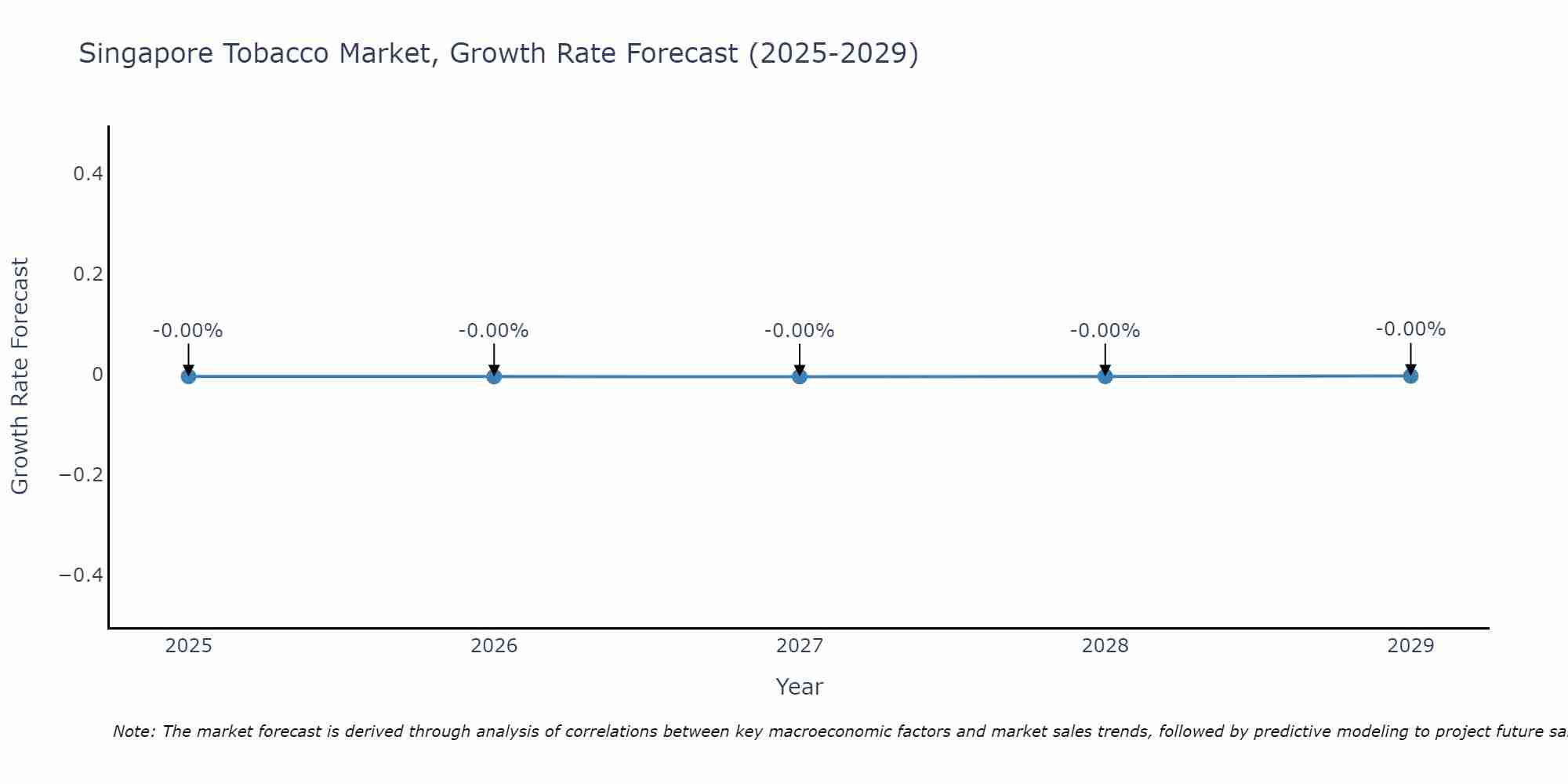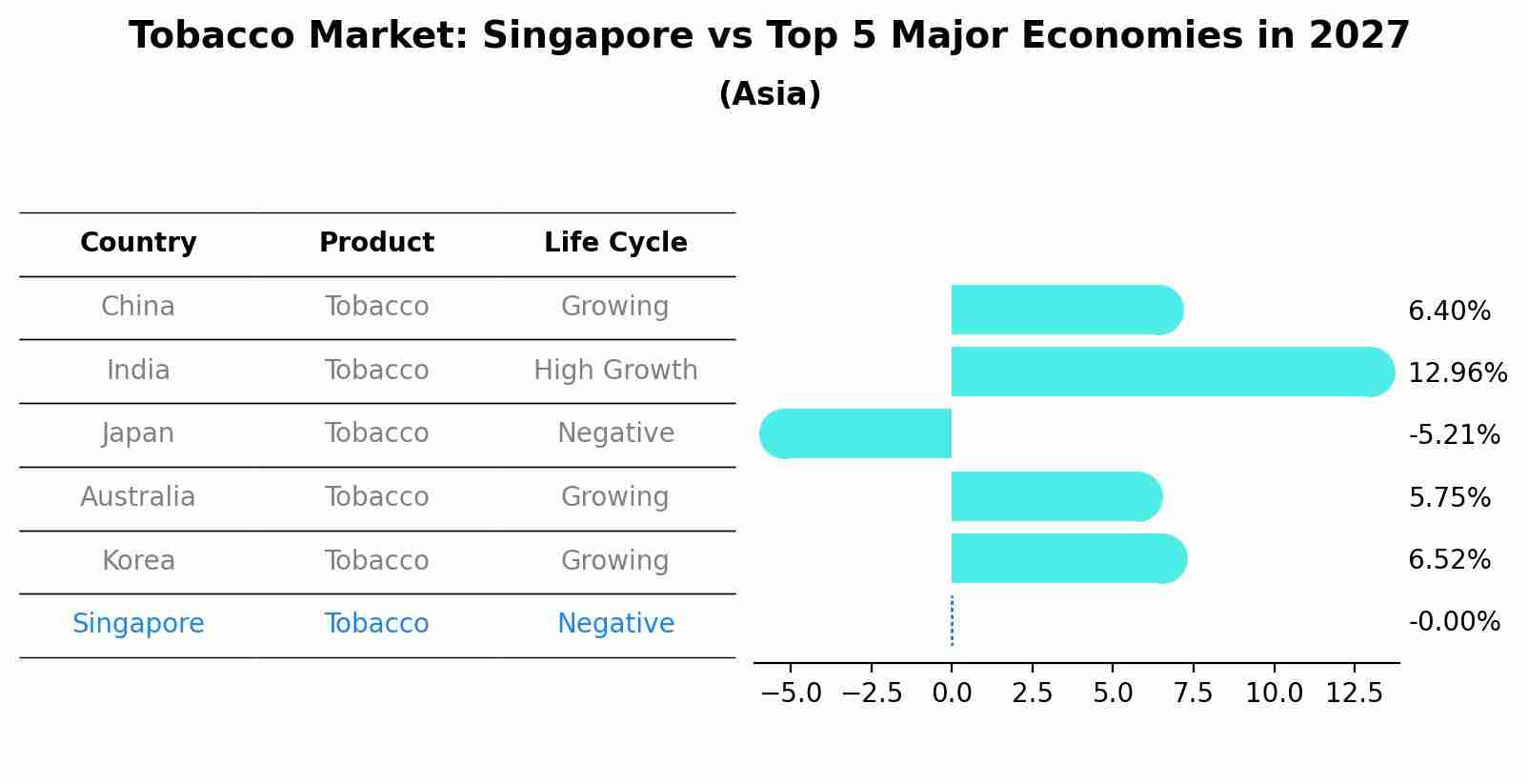Singapore Tobacco Market (2025-2031) Outlook | Trends, Analysis, Growth, Share, Value, Revenue, Forecast, Companies, Size & Industry
| Product Code: ETC227727 | Publication Date: Aug 2022 | Updated Date: Aug 2025 | Product Type: Market Research Report | |
| Publisher: 6Wresearch | No. of Pages: 75 | No. of Figures: 35 | No. of Tables: 20 | |
Singapore Tobacco Market Size Growth Rate
The Singapore Tobacco Market is projected to witness mixed growth rate patterns during 2025 to 2029. The growth rate starts at -0.00% in 2025 and reaches -0.00% by 2029.

Tobacco Market: Singapore vs Top 5 Major Economies in 2027 (Asia)
By 2027, Singapore's Tobacco market is forecasted to achieve a negative growth rate of -0.00%, with China leading the Asia region, followed by India, Japan, Australia and South Korea.

Singapore Tobacco Market Synopsis
The tobacco market in Singapore is characterized by stringent regulations and high taxes imposed on tobacco products to discourage consumption and promote public health. As a result, the market is relatively small and limited. Government campaigns and initiatives to reduce smoking rates have impacted the overall outlook of the tobacco market, which remains under pressure due to changing consumer preferences and health-conscious trends.
Drivers of the Market
The Singapore silver mining market is not characterized by domestic mining activities but rather by the demand for refined silver in various industries, including electronics, jewelry, and healthcare. The market is driven by technological advancements requiring silver components, such as semiconductors and photovoltaic cells. Moreover, the ongoing appeal of silver as a precious metal for investment and jewelry contributes to sustained demand.
Challenges of the Market
The Singapore tobacco market faces significant challenges due to stringent government regulations, high taxes, and growing health concerns. Smoking rates have been steadily declining due to anti-smoking campaigns and policies, which directly affect the profitability of tobacco companies. Furthermore, the emergence of alternative nicotine delivery methods like vaping has altered consumer preferences and disrupted the traditional tobacco market.
COVID-19 Impact on the Market
The tobacco market in Singapore, already subject to stringent regulations and high taxes, saw a shift in consumer behavior during the COVID-19 pandemic. Concerns about respiratory health prompted some smokers to consider quitting, leading to a decline in traditional tobacco consumption. However, the market also saw an increase in the sale of alternative tobacco products, such as e-cigarettes and heat-not-burn devices. The pandemic highlighted the need for flexibility and innovation in the tobacco industry, with companies exploring reduced-risk products and online sales channels to adapt to changing consumer preferences and regulatory landscapes.
Key Players in the Market
In Singapore tobacco market, major players include British American Tobacco (BAT) and Japan Tobacco International (JTI). These multinational tobacco companies produce and distribute a variety of cigarette brands in the country, adhering to Singapore strict tobacco regulations.
Key Highlights of the Report:
- Singapore Tobacco Market Outlook
- Market Size of Singapore Tobacco Market, 2024
- Forecast of Singapore Tobacco Market, 2031
- Historical Data and Forecast of Singapore Tobacco Revenues & Volume for the Period 2021-2031
- Singapore Tobacco Market Trend Evolution
- Singapore Tobacco Market Drivers and Challenges
- Singapore Tobacco Price Trends
- Singapore Tobacco Porter's Five Forces
- Singapore Tobacco Industry Life Cycle
- Historical Data and Forecast of Singapore Tobacco Market Revenues & Volume By Product for the Period 2021-2031
- Historical Data and Forecast of Singapore Tobacco Market Revenues & Volume By Smokeless for the Period 2021-2031
- Historical Data and Forecast of Singapore Tobacco Market Revenues & Volume By Cigarettes for the Period 2021-2031
- Historical Data and Forecast of Singapore Tobacco Market Revenues & Volume By Cigar & Cigarillos for the Period 2021-2031
- Historical Data and Forecast of Singapore Tobacco Market Revenues & Volume By Next Generation Products for the Period 2021-2031
- Historical Data and Forecast of Singapore Tobacco Market Revenues & Volume By Waterpipes for the Period 2021-2031
- Historical Data and Forecast of Singapore Tobacco Market Revenues & Volume By Distribution Channel for the Period 2021-2031
- Historical Data and Forecast of Singapore Tobacco Market Revenues & Volume By Offline for the Period 2021-2031
- Historical Data and Forecast of Singapore Tobacco Market Revenues & Volume By Online for the Period 2021-2031
- Singapore Tobacco Import Export Trade Statistics
- Market Opportunity Assessment By Product
- Market Opportunity Assessment By Distribution Channel
- Singapore Tobacco Top Companies Market Share
- Singapore Tobacco Competitive Benchmarking By Technical and Operational Parameters
- Singapore Tobacco Company Profiles
- Singapore Tobacco Key Strategic Recommendations
Frequently Asked Questions About the Market Study (FAQs):
1 Executive Summary |
2 Introduction |
2.1 Key Highlights of the Report |
2.2 Report Description |
2.3 Market Scope & Segmentation |
2.4 Research Methodology |
2.5 Assumptions |
3 Singapore Tobacco Market Overview |
3.1 Singapore Country Macro Economic Indicators |
3.2 Singapore Tobacco Market Revenues & Volume, 2021 & 2031F |
3.3 Singapore Tobacco Market - Industry Life Cycle |
3.4 Singapore Tobacco Market - Porter's Five Forces |
3.5 Singapore Tobacco Market Revenues & Volume Share, By Product , 2021 & 2031F |
3.6 Singapore Tobacco Market Revenues & Volume Share, By Distribution Channel, 2021 & 2031F |
4 Singapore Tobacco Market Dynamics |
4.1 Impact Analysis |
4.2 Market Drivers |
4.2.1 Changing consumer preferences towards premium and flavored tobacco products |
4.2.2 Increasing disposable income leading to higher spending on tobacco products |
4.2.3 Growing tourism industry in Singapore attracting foreign smokers |
4.3 Market Restraints |
4.3.1 Government regulations and strict tobacco control policies |
4.3.2 Increasing health awareness and anti-smoking campaigns |
4.3.3 Rising taxes and excise duties on tobacco products |
5 Singapore Tobacco Market Trends |
6 Singapore Tobacco Market, By Types |
6.1 Singapore Tobacco Market, By Product |
6.1.1 Overview and Analysis |
6.1.2 Singapore Tobacco Market Revenues & Volume, By Product , 2021-2031F |
6.1.3 Singapore Tobacco Market Revenues & Volume, By Smokeless, 2021-2031F |
6.1.4 Singapore Tobacco Market Revenues & Volume, By Cigarettes, 2021-2031F |
6.1.5 Singapore Tobacco Market Revenues & Volume, By Cigar & Cigarillos, 2021-2031F |
6.1.6 Singapore Tobacco Market Revenues & Volume, By Next Generation Products, 2021-2031F |
6.1.7 Singapore Tobacco Market Revenues & Volume, By Waterpipes, 2021-2031F |
6.2 Singapore Tobacco Market, By Distribution Channel |
6.2.1 Overview and Analysis |
6.2.2 Singapore Tobacco Market Revenues & Volume, By Offline, 2021-2031F |
6.2.3 Singapore Tobacco Market Revenues & Volume, By Online, 2021-2031F |
7 Singapore Tobacco Market Import-Export Trade Statistics |
7.1 Singapore Tobacco Market Export to Major Countries |
7.2 Singapore Tobacco Market Imports from Major Countries |
8 Singapore Tobacco Market Key Performance Indicators |
8.1 Number of new product launches and innovations in the tobacco market |
8.2 Average spending per capita on tobacco products |
8.3 Percentage of smokers in the adult population |
9 Singapore Tobacco Market - Opportunity Assessment |
9.1 Singapore Tobacco Market Opportunity Assessment, By Product , 2021 & 2031F |
9.2 Singapore Tobacco Market Opportunity Assessment, By Distribution Channel, 2021 & 2031F |
10 Singapore Tobacco Market - Competitive Landscape |
10.1 Singapore Tobacco Market Revenue Share, By Companies, 2024 |
10.2 Singapore Tobacco Market Competitive Benchmarking, By Operating and Technical Parameters |
11 Company Profiles |
12 Recommendations |
13 Disclaimer |
- Single User License$ 1,995
- Department License$ 2,400
- Site License$ 3,120
- Global License$ 3,795
Search
Related Reports
- ASEAN Bearings Market (2025-2031) | Strategy, Consumer Insights, Analysis, Investment Trends, Opportunities, Growth, Size, Share, Industry, Revenue, Segments, Value, Segmentation, Supply, Forecast, Restraints, Outlook, Competition, Drivers, Trends, Demand, Pricing Analysis, Competitive, Strategic Insights, Companies, Challenges
- Europe Flooring Market (2025-2031) | Outlook, Share, Industry, Trends, Forecast, Companies, Revenue, Size, Analysis, Growth & Value
- Saudi Arabia Manlift Market (2025-2031) | Outlook, Size, Growth, Trends, Companies, Industry, Revenue, Value, Share, Forecast & Analysis
- Uganda Excavator, Crane, and Wheel Loaders Market (2025-2031) | Strategy, Consumer Insights, Analysis, Investment Trends, Opportunities, Growth, Size, Share, Industry, Revenue, Segments, Value, Segmentation, Supply, Forecast, Restraints, Outlook, Competition, Drivers, Trends, Demand, Pricing Analysis, Competitive, Strategic Insights, Companies, Challenges
- Rwanda Excavator, Crane, and Wheel Loaders Market (2025-2031) | Strategy, Consumer Insights, Analysis, Investment Trends, Opportunities, Growth, Size, Share, Industry, Revenue, Segments, Value, Segmentation, Supply, Forecast, Restraints, Outlook, Competition, Drivers, Trends, Demand, Pricing Analysis, Competitive, Strategic Insights, Companies, Challenges
- Kenya Excavator, Crane, and Wheel Loaders Market (2025-2031) | Strategy, Consumer Insights, Analysis, Investment Trends, Opportunities, Growth, Size, Share, Industry, Revenue, Segments, Value, Segmentation, Supply, Forecast, Restraints, Outlook, Competition, Drivers, Trends, Demand, Pricing Analysis, Competitive, Strategic Insights, Companies, Challenges
- Angola Excavator, Crane, and Wheel Loaders Market (2025-2031) | Strategy, Consumer Insights, Analysis, Investment Trends, Opportunities, Growth, Size, Share, Industry, Revenue, Segments, Value, Segmentation, Supply, Forecast, Restraints, Outlook, Competition, Drivers, Trends, Demand, Pricing Analysis, Competitive, Strategic Insights, Companies, Challenges
- Israel Intelligent Transport System Market (2025-2031) | Strategy, Consumer Insights, Analysis, Investment Trends, Opportunities, Growth, Size, Share, Industry, Revenue, Segments, Value, Segmentation, Supply, Forecast, Restraints, Outlook, Competition, Drivers, Trends, Demand, Pricing Analysis, Competitive, Strategic Insights, Companies, Challenges
- Uganda Precast and Aggregate Market (2025-2031) | Strategy, Consumer Insights, Analysis, Investment Trends, Opportunities, Growth, Size, Share, Industry, Revenue, Segments, Value, Segmentation, Supply, Forecast, Restraints, Outlook, Competition, Drivers, Trends, Demand, Pricing Analysis, Competitive, Strategic Insights, Companies, Challenges
- Australia IT Asset Disposal Market (2025-2031) | Strategy, Consumer Insights, Analysis, Investment Trends, Opportunities, Growth, Size, Share, Industry, Revenue, Segments, Value, Segmentation, Supply, Forecast, Restraints, Outlook, Competition, Drivers, Trends, Demand, Pricing Analysis, Competitive, Strategic Insights, Companies, Challenges
Industry Events and Analyst Meet
Our Clients
Whitepaper
- Middle East & Africa Commercial Security Market Click here to view more.
- Middle East & Africa Fire Safety Systems & Equipment Market Click here to view more.
- GCC Drone Market Click here to view more.
- Middle East Lighting Fixture Market Click here to view more.
- GCC Physical & Perimeter Security Market Click here to view more.
6WResearch In News
- Doha a strategic location for EV manufacturing hub: IPA Qatar
- Demand for luxury TVs surging in the GCC, says Samsung
- Empowering Growth: The Thriving Journey of Bangladesh’s Cable Industry
- Demand for luxury TVs surging in the GCC, says Samsung
- Video call with a traditional healer? Once unthinkable, it’s now common in South Africa
- Intelligent Buildings To Smooth GCC’s Path To Net Zero













